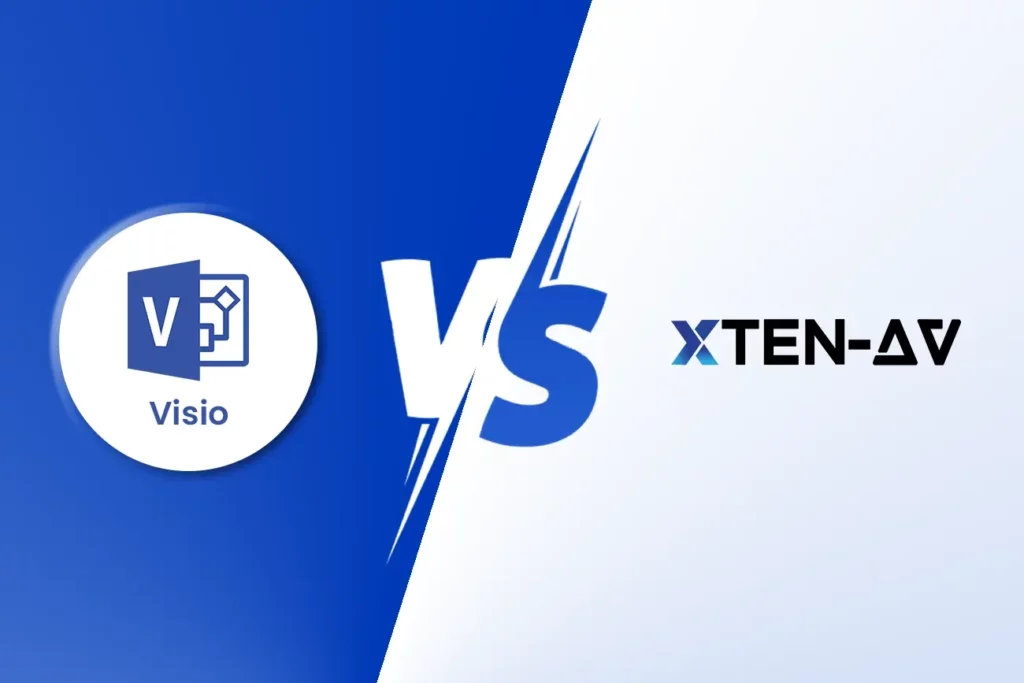AV system design is a time-consuming and complex process where every step requires precision and seamless collaboration. The steps include rack layout designs, signal flow diagrams, and cable schedules. It also comprises the creation and management of proposals and AV projects.
However, with the right AV diagram & schematic software by your side, you can streamline this process. The best software for making diagrams allows you to create professional diagrams that are of high quality & accurate. These diagrams include system plans and automate different project aspects. You can also use it to modify the AV design to meet the client’s needs.
It comprises a user-friendly interface and competitive subscription plans of industry standards. But with several diagramming and design tools on the market, how will you decide which is the right one for AV design needs?
Therefore, we bring you a comprehensive comparison guide on XTEN-AV vs Microsoft Visio. This guide will break down the features, strengths, and differences between XTEN-AV and Microsoft Visio. By the end, you can decide which software best suits your workflow and make it more precise, clear, and efficient.
Key Takeaways:
- XTEN-AV is a one-stop cloud-based AI-powered av design platform. It allows you to create & modify AV designs and proposals and manage different aspects of AV projects.
- Microsoft Visio is a generic software for making diagrams. It allows you to create diagrams and visualize data for better understanding.
- XTEN-AV comprises AV-oriented AI automation, proposal documentation, and project management with features like real-time collaboration.
- In MS Visio, the user has to place shapes manually. Additionally, they have to rely on Microsoft 365 apps services for design creation & execution. Users can also access data by linking it from sources like Excel, SQL Server, or SharePoint.
- XTEN-AV offers different subscription plans for the same software, while Microsoft Visio pricing differs for other versions. As a result, users often have to switch software versions depending on their use.
- You must choose XTEN-AV if you want to create or modify an AV design for a project. You can also select the tool to streamline proposals and manage the project effectively. However, you must choose Visio when you need a visualization tool for various IT, business, or process mapping. Visio also offers integration with the Microsoft Office 365 ecosystem and Microsoft Teams.
- Between XTEN-AV and Microsoft Visio, the former is a better alternative. XTEN-AV boosts productivity and saves time by up to 80 percent, thanks to AI-automated diagrams. These diagrams include floor plans, front elevation, rack and speaker layout, and line schematics for AV professionals.
The all-in-one solution for your AV needs
Transform your audio-visual experience with XTEN-AV.
No Credit Card required
XTEN-AV and Microsoft Visio Comparison
XTEN-AV and MS Visio are software for making diagrams and visuals such as flow charts, mind maps, network diagrams, floor plans, and more. But there’s more to both platforms than a single statement. Therefore, let’s learn about both platforms with a detailed overview.
XTEN-AV
XTEN-AV is a web-based automated audio-visual design platform. It comes with a Role Based Access Control (RBAC) system, which ensures that each individual has access to the project as per the roles.
XTEN-AV caters specifically to AV professionals and helps them create amazing AV system designs. It also helps them curate stellar proposal documentation, all while efficiently managing the project.
It comprises XDRAW and x.doc, which help you enhance the AV design and improve the efficiency of project proposals. It also includes X-PRO, which allows you to streamline the project. You can also manage different aspects of AV projects, such as inventory, purchase orders, labor hours, and more.
Key Features
XTEN-AV allows systems integrators and AV integration firms to create automated and straightforward AV system designs. Pre-existing templates, scheduled cable management, and seamless schematics streamline these designs.
AV professionals can store their work done on the ‘My Templates’ by clicking on the ‘X-DRAW templates’ option. The option is available under the ‘Templates option’ from the left navigation menu. They can also access the platform anywhere with cloud-based access.
Real-time tracking of proposals and templates for information on any modifications or updates by colleagues or clients
100+ predesigned templates, legally binding e-signatures, customization of different elements, one-page scroll, document, presentation, and PDF integration in the audio-visual proposal
Improve project workflow by creating new tasks linked to different events. It also provides on-field technicians with access to the software and time-tracking to determine the working hours. Admin/Project manager can create and edit inventory, purchase orders, & invoices. The platform also provides them with detailed information on the return on investments (ROI).
Microsoft Visio
Visio is a diagrammatic software used to create flowcharts, organizational charts, mind maps, network diagrams, and more. These different visuals help simplify complex information, making it easier to understand and improving productivity. It comprises several templates, easily
editable shapes, and smooth integration with Microsoft 365.
Microsoft Visio also offers real-time collaboration, compatibility with the Office Suite, and sharing with Onedrive and Sharepoint. As a result, it is an excellent tool for different users, ranging from business owners to individuals/freelancers. However, unlike XTEN-AV, Visio is a generic software that does not cater to a specific audience or business.
There are different versions of Visio available as a standalone software or through a Microsoft 365 subscription. These versions include Visio 2003, Visio 2010, 2013, 2016, 2019, and 2021. Moreover, each version comes with Standard and Professional editions.
Here’s a breakdown of the features that Visio offers:
Key Features
Access to more than thousands of shapes, product icons, and Custom shapes with programmability
Ability to create cross-functional flowcharts and detailed network diagrams. It can also seamlessly create IT diagrams on cloud computing platforms such as Azure and Amazon Web Services (AWS)
Tools to create floor plans, office layouts, piping & instrumentation diagrams (P&ID) and engineering drawings
Data Connectivity with two-way synchronization
Integration with Power BI, Power Automate, and Microsoft Office Suite and support to AutoCad and data graphics file format
Now that we have had an overview of both the diagrammatic tools, let’s make a feature comparison between XTEN-AV and Microsoft Visio.
Feature Comparison: XTEN-AV vs Microsoft Visio
XTEN-AV is a similar tool to Microsoft Visio, and it is also used for diagrammatic purposes. However, there are multiple differences between the two tools. These differences are because of their features, which ultimately lead to different use cases.
Understanding these differences can help you use both tools efficiently or use each tool as per the project’s requirement. Here is a table showing a better feature comparison between XTEN AV and Microsoft Visio.
Features | XTEN-AV | Microsoft Visio |
Access Control Permissions | Yes | Yes |
APIs | Yes | Yes |
Auto Updates | Yes | Yes |
Brainstorming | No | No |
Chat Messaging | Yes | No |
Collaboration Tools | Yes | Yes |
Commenting/Notes | Yes | Yes |
Communication Management | Yes | No |
Customizable Reports | Yes | No |
Data Import/Export | Yes | Yes |
Data Visualization | Yes | Yes |
Design Management | Yes | Yes |
Document Embedding | Yes | Yes |
Document Storage | Yes | Yes |
Drag & Drop | Yes | Yes |
File Management | Yes | Yes |
File Sharing | Yes | Yes |
Flowchart | Yes | Yes |
Freehand Sketch | Yes | Yes |
Gantt/Timeline View | No | No |
Graphical Data Presentation | Yes | No |
Graphical Workflow Editor | Yes | Yes |
Image Library | Yes | No |
Mind Maps | No | Yes |
Multi-Language | Yes | Yes |
Network Diagram | Yes | Yes |
Organizational Charting | No | Yes |
Project Planning | Yes | No |
Real-Time Data | Yes | Yes |
Real-Time Updates | Yes | No |
Sign Sign on | Yes | No |
SSL Security | Yes | No |
Strategic Planning | No | No |
Task Management | Yes | Yes |
Templates | Yes | Yes |
Third Party Integration | Yes | Yes |
Version Control | Yes | Yes |
Whiteboard | No | No |
Wiki | No | No |
Workflow Management | Yes | Yes |
Let’s understand the feature differences in different aspects, such as system design & diagramming, document creation & customization, and more.
System Design & Diagramming
XTEN-AV
XTEN-AV features an AV professional-centric image library that comprises locks for different AV components. It contains products from real-world and top-rated product manufacturers. Therefore, users can create the required designs by selecting the components as per their preferred specifications.
X-Pro represents real-time data in charts and KPI widgets based on AV projects in the X-Pro dashboard. The data comprises labor vs material costs, profitability, schedule status, and more.
It offers one-click data-oriented reports comprising bar/line graphs and pie charts. The AI-powered automation ensures that the platform automatically updates the inventory and tracks time efficiently.
It also displays all the details in visual data. These details include inventory & purchase details, login hours, project completion, and budget details. These details are updated in real time as soon as there is a change in status.
Microsoft Visio
Visio creates data graphics or visuals, such as bar graphs, icon sets, color-by-value fills, and text callouts. Users can make these by linking diagrams with the data fields, unlike XTEN-AV, which provides real-time data.
Vision generates flowcharts and organizational charts from an external source to update data on different platforms. These sources are Microsoft Excel, Google Sheets, and any other Microsoft Office Suite tool. As a result, updating the information becomes a complex and time-consuming process.
Similarly, the Image Library in Visio does not cater to any specific audience or profession. It requires the users to customize the shapes or symbols manually. As a result, AV designs create the AV gears from scratch.
Moreover, it lacks XTEN-AV’s other features, such as detailed device representation and seamless information in proposals. Microsoft Visio also lacks features like the Bill of Materials (BoM). Hence, AV designers have to separately list the products they need to create a BoM and manage proposal documentations themselves.
Document Creation & Customization
XTEN AV
XTEN-AV allows you to download the entire folder as a ZIP file and organize the projects with multiple tags. It ensures efficient & seamless file organization and tracking when you download the files.
The platform allows you to view or create new versions of each design. It also comprises project-level settings & stages and chatter. The chatter option allows team members to post real-time updates, comments, and files for seamless inter-team collaboration.
Visio
Visio relies on the Operating Software (OS) or SharePoint libraries. It manages the diagrammatic files as separate documents. Therefore, it lacks built-in documentation features, bulk export in the ZIP format, and easy AV project management.
It also lacks project phases and centralized project settings. As a result, designers have to build or manage all diagram-related functions and controls in a separate tool.
Integration & Automation
XTEN AV
XTEN-AV has direct and native integration with project management & CRM platforms like monday.com, Zoho, Salesforce, Dynamic 365, and HubSpot. It also has accounting tools such as QuickBooks and Q360 and an AV catalog with Yamaha ProVisionaire Plan and Ricoh. It comprises real-time data from the products available in the inventory.
The platform also features open Rest APIs that automate contact synchronization and the BoM creation. XTEN-AV’s AI automation ensures team members have real-time updates for any changes to the design, proposal, or project.
Microsoft Visio
Visio features limited integration with Microsoft Office and Microsoft tools like Teams, SharePoint, OneDrive, and Power BI. Additionally, Visio does not automatically provide real-time data. To access the real-time data, users must refresh the data links manually.
Although Visio features cloud access, it offers access only for co-authoring the diagrams.
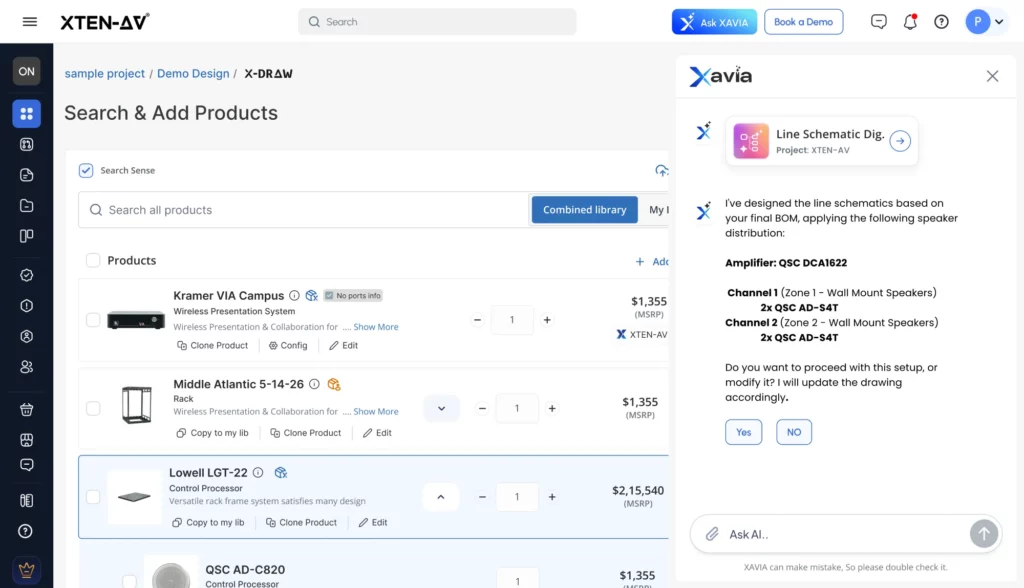
Collaboration & Communication
XTEN AV
XTEN-AV has a built-in chat/messaging feature, allowing all users to communicate in nested messages. Users can also exchange ideas about a particular idea or concept and collaborate in real-time. As a result, the platform ensures seamless tracking of feedback, suggestions, and decisions related to specific design elements.
The platform also offers a complete bird’s eye view of every action and update in a team. Maintaining transparency within the team and accountability of the team members.
Microsoft Visio
Contrary to XTEN-AV, Microsoft Visio lacks an internal chat feature. Hence, users do not receive prompts to use apps like Teams and Skype to have conversations or discussions on diagrams. It requires external apps like SharePoint and OneDrive and their audit logs to gain insight into any activity.
Planning & Strategy
XTEN-AV
XTEN-AV offers all the tools that are used in project planning through the X-Pro tool. It integrates design tools, proposal management, and project management into a single software. Hence, the users can make high-level decisions seamlessly. It also allows users to manage tasks with features like task creation, assignment, and tracking.
Microsoft Visio
Unlike XTEN-AV, Visio lacks project management features and cannot be used for detailed project planning. Since it is primarily a diagramming tool, it cannot support strategized workflows, nor does it comprise task management features.
XTEN-AV vs Visio: When should you choose what?
XTEN-AV and Microsoft Visio are diagrammatic tools, but each has a different use. You must choose XTEN-AV for AV system designs and Microsoft Visio for general diagramming and visualization. But what are the reasons for various use cases?
Therefore, we bring you a detailed breakdown that will help you determine when to choose in the XTEN-AV vs Visio battle.
XTEN-AV
Automated Diagrams & Product Library
XTEN-AV increases your productivity with automated and easy-to-understand designs. These designs include cable & rack layout, signal flow, floor plans, and front elevation that meet the AVIXA standards.
Project Planning & Task Management
XTEN-AV helps you plan projects and manage tasks in a way that prevents the need to move from one application to another. It does so by providing features like visual scheduling tools and built-in version control.
Visual scheduling tools comprise a calendar dashboard and linked event timelines to assign and track tasks. On the other hand, built-in version control allows you to track and save any changes made to the design.
Collaboration & File Management
XTEN-AV allows smooth collaboration & file management with features such as in-app chat and project-centric file management. The in-app chat enables team members to provide feedback on particular sections of the design. Team members can discuss different sections within the diagram.
Project-oriented file management allows the user to add tags to the project. It makes file search or downloading easier. Users can also save the entire project at different locations as ZIP files.
Microsoft Visio
General Diagramming Flexibility
Microsoft Visio is an excellent diagrammatic and visualizing tool. You can use it to create designs, mind maps, organizational charts, flow charts, network maps, and UML. It also allows you to create or import any stencil or drawing shape/element to suit the diagrammatic needs.
However, the diagrammatic needs vary. For example, the UML comprises class and sequence diagrams, while flowcharts represent activities, decisions, and events.
Online Editing & Power BI Integration
It allows you to view, create new, and modify existing diagrams without the need to install desktop software. You can embed the diagrams in Visio as third-party or specialized visual components in Power BI. Additionally, you can use the diagrams as any Power BI visual and pin them beside bar charts, maps, and KPIs.
Microsoft 365 & Data-Oriented Workflow
Visio’s data visualizer feature allows you to create flowcharts or organization charts automatically. Charts are made based on the data from rows in Microsoft Excel or Google Sheets. You can update them by refreshing the link of your document or the document itself.
It includes Automatic Link Wizard and Data Graphics tools. These tools allow you to link any portion of the diagram with live data sources. You can then represent that data in the form of bars, icons, or different colors.
XTEN-AV: An Alternative to Microsoft Visio
There are many diagrammatic and project management tools similar to Microsoft Visio. One of these tools is XTEN-AV, which caters to a specific audience: AV professionals. It provides AV-centric diagrams, elements, proposals, and project management tools with an intuitive interface.
These two pointers alone make it an alternative to Microsoft Visio, a general diagrammatic tool. However, there is more to the XTEN-AV than meets the eye. Here are the reasons or features that make it a better alternative to Microsoft Visio.
AI Automation
XTEN-AV comprises AI-powered drawings. It allows the platform to automatically generate floor plans, line schematics, and rack layouts. Products listed on the Bill of Materials (BoM) lead to the creation of these designs.
The AI automation automatically organizes each component for an optimal design, saving time and effort, which increases productivity. These components include a monitor, projector, speakers, cables, and more.
On the other hand, you’d need to manually place every component, shape, and connector in Visio. It can be time-consuming and tedious, making AV system design inefficient and reducing productivity.
Extensive Equipment Library
While Visio has generic stencils for the diagram creation, XTEN-AV features an extensive product library. In this library, you can find and use more than 1.5 million products from 5,200+ brands to create the AV design. These products can cater to every client’s requirements and needs.
Seamless Project Management
XTEN-AV comprises X-PRO, which allows you to manage your AV projects. It divides the projects as per phases, milestones, or deadlines without the need for multiple project management applications. You can also create task lists and track inventory for seamless project completion.
Built-in Collaboration & Chat Feature
XTEN-AV offers a built-in chat feature in the form of threads. This feature allows every team member to discuss the AV design within the team. It eliminates the need to use communication applications like Teams or Skype.
XTEN-AV also features real-time collaboration, which provides you with real-time updates through emails and text messages. You receive updates in case of any suggestions, queries, or changes to the design.
Cloud-Based Unified Platform
XTEN-AV is a one-stop platform for all your design, documentation, and project management needs, and it has a cloud-based login. This means that you don’t need to download a separate application to your device. As a result, you can access the platform anywhere and anytime from any device or OS.
The all-in-one solution for your AV needs
Transform your audio-visual experience with XTEN-AV.
No Credit Card required
AV Design Mastery + Winning Proposals = 10x Productivity!
- ✔ Automatic Cable Labeling & Styling
- ✔100+ Free Proposal Templates
- ✔ Upload & Create Floor Plans
- ✔1.5M Products from 5200 Brands
- ✔ AI-powered ‘Search Sense'
- ✔Legally Binding Digital Signatures
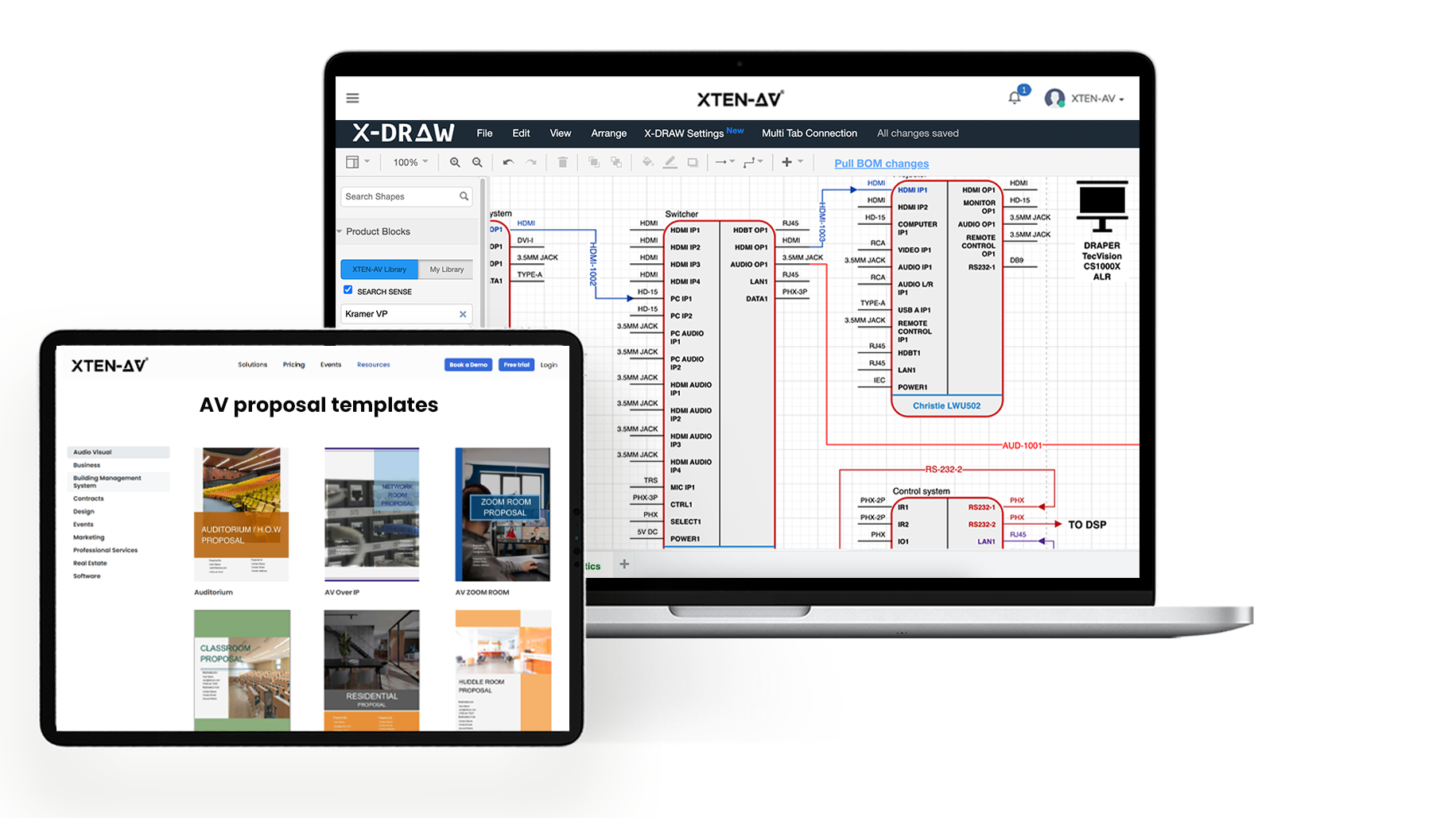
Conclusion
There is no doubt that choosing the right tool can exponentially make drawing designs, floor plans, and flowcharts easier. However, the right tool should cater to the specific needs of your profession.
You may have access to limited elements and shapes if you don’t use the right tool. It can lead to time-consuming and vague or unreadable schematics. This is where XTEN AV shines brighter than Microsoft Visio.
XTEN-AV is a leading cloud-based AV design, proposal, and project management software platform. It uses AI, automation, and cloud computing to prevent the need for several generic tools. As a result, AV integrators and designers can work faster and better than ever before.
So, what are you waiting for? Sign on to XTEN-AV now and get a free 15-day trial. You can also book a free demo to streamline or revamp your AV project design.
FAQs
XTEN-AV is better than Microsoft Visio as it comprises AI-powered automation for diagram creation. It caters specifically to a particular audience: AV professionals. It allows AV professionals to create proposal documents and manage projects, something that Microsoft Visio lacks.
Microsoft Visio is available with the Microsoft 365 commercial plans. Hence, users can use it to view and edit basic diagrams for free. However, the users have to pay for features like using different shapes and product icons, creating flowcharts, network & IT diagrams, mind maps, organizational charts, and Power BI integration.
Explore more by topic
AV Design Mastery + Winning Proposals = 10x Productivity!
- Automatic Cable Labeling & Styling
- 100+ Free Proposal Templates
- Upload & Create Floor Plans
- 1.5M Products from 5200 Brands
- AI-powered ‘Search Sense'
- Legally Binding Digital Signatures
No Credit Card Required
Related Blogs
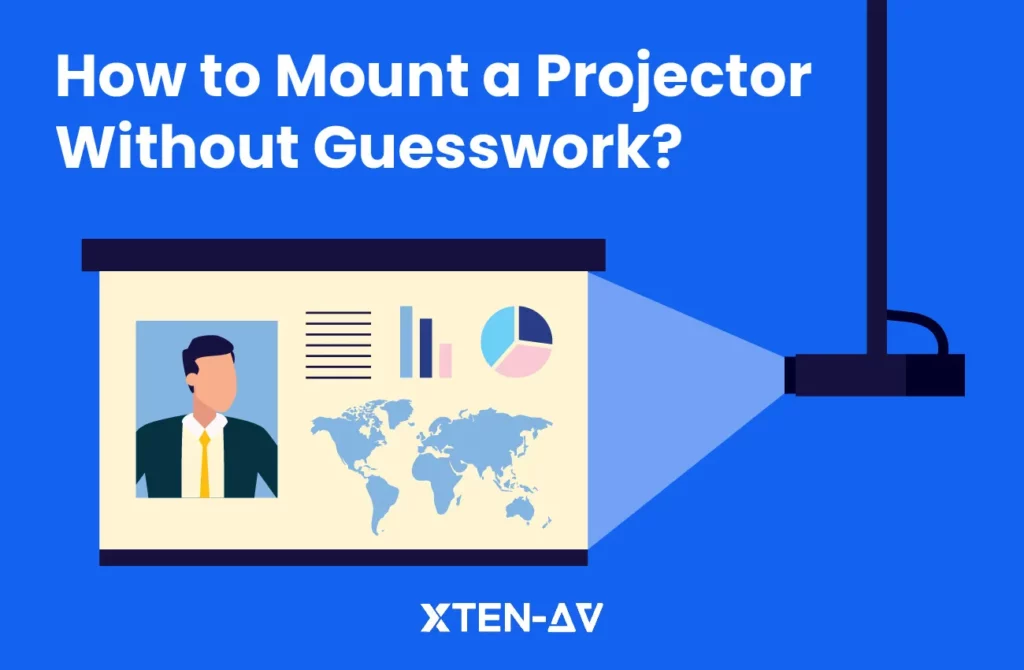
-
- Posted by Sahil Dhingra
Audio Visual How to Mount a Projector Without Guesswork Vibhav Singh Published...
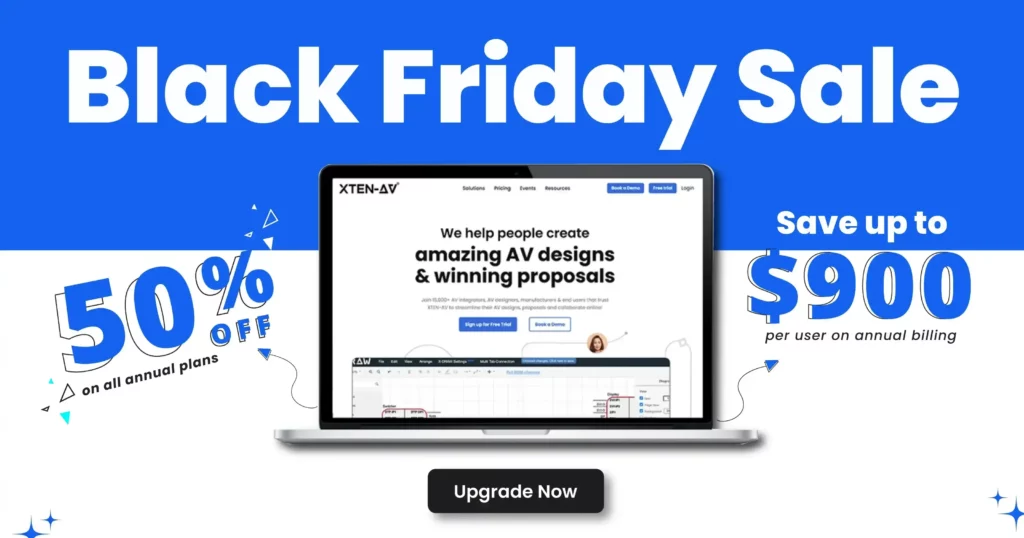
-
- Posted by Sahil Dhingra
XTEN-AV Black Friday and Cyber Monday Deals in 2025 For Audio Visual...

-
- Posted by Sahil Dhingra
Audio Visual Access Control System Installation Guide for Security System Integrators, Designers...
